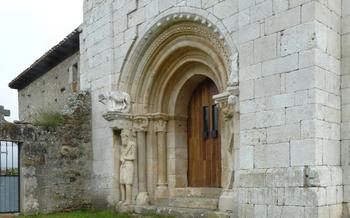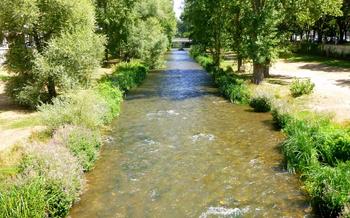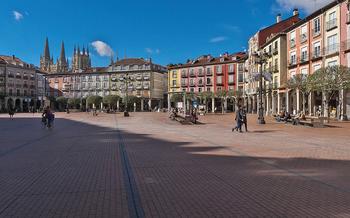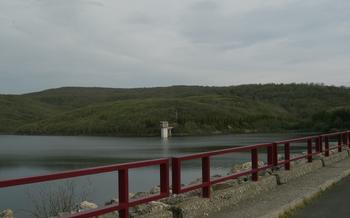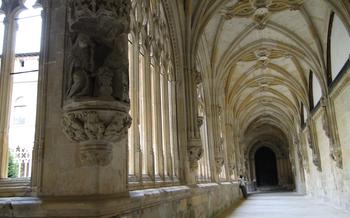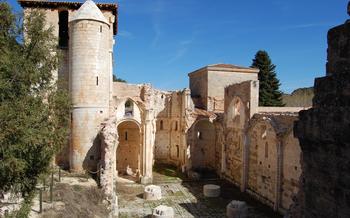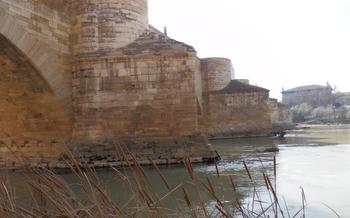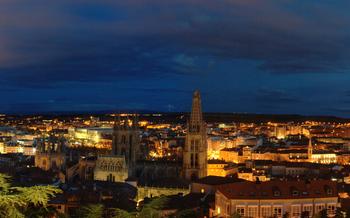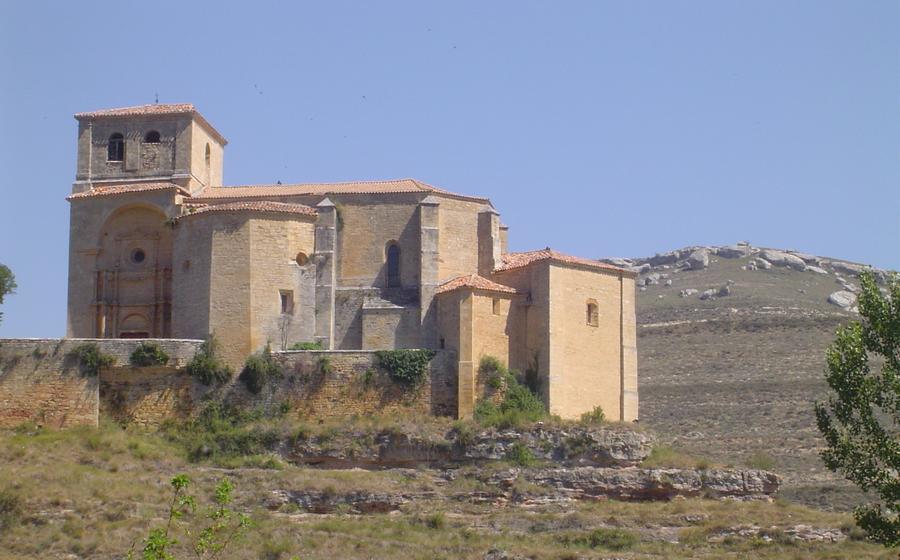
Valle de Sedano
- Valle de Sedano: A Natural Paradise in Burgos
- Exploring the Karst Landscape
- Hiking and Biking Trails
- Rock Climbing and Canyoneering
- Water Sports and Adventure Activities
- Visiting the Medieval Villages
- Sampling the Local Cuisine
- Discovering the Local Crafts
- Attending Local Festivals and Events
- Visiting the Rock Art Sites
- Exploring the Abandoned Villages
- Stargazing in the Valle de Sedano
- Visiting the Monasteries and Churches
- Enjoying the Local Music and Dance
- Insider Tip: Hidden Gems of the Valle de Sedano
Valle de Sedano: A Natural Paradise in Burgos
Nestled in the heart of the province of Burgos, in northern Spain, lies the Valle de Sedano, a breathtaking natural paradise that beckons travelers with its unique beauty and diverse attractions. This enchanting valley, with its pristine landscapes and rich cultural heritage, is a treasure trove for nature enthusiasts, adventure seekers, and history buffs alike.
The Valle de Sedano boasts a fascinating history that dates back to prehistoric times, as evidenced by the numerous rock art sites scattered throughout the valley. These ancient artworks offer a glimpse into the lives of the early inhabitants of the region and provide valuable insights into their culture and beliefs. The valley also played a significant role during the Middle Ages, as evidenced by the well-preserved medieval villages that dot the landscape.
In addition to its historical significance, the Valle de Sedano is renowned for its stunning natural beauty. The valley is home to a diverse range of landscapes, from lush forests and rolling hills to towering cliffs and deep gorges. The crystal-clear waters of the Ebro River meander through the valley, creating a tranquil oasis amidst the rugged terrain.
The Valle de Sedano is a haven for outdoor enthusiasts, offering a multitude of activities to suit all tastes and abilities. From hiking and biking to rock climbing and spelunking, the valley provides endless opportunities for adventure and exploration. Whether you're a seasoned hiker looking for a challenging trek or a family seeking a leisurely stroll, the Valle de Sedano has something for everyone.
The valley is also committed to sustainable tourism, ensuring that its natural and cultural heritage is preserved for future generations. Visitors are encouraged to explore the valley responsibly, respecting the environment and supporting the local communities. By embracing sustainable practices, the Valle de Sedano aims to maintain its pristine beauty while promoting economic growth and cultural preservation.
Exploring the Karst Landscape
The Valle de Sedano is renowned for its breathtaking karst landscape, a mesmerizing tapestry of caves, gorges, and sinkholes sculpted by the relentless erosion of limestone over millions of years. This unique geological phenomenon has transformed the valley into a paradise for spelunkers and nature enthusiasts, offering a subterranean world of wonder and exploration.
One of the most remarkable features of the karst landscape is the Cueva del Ojo Guareña, a vast cave system that ranks among the most impressive in Spain. With its awe-inspiring stalactites and stalagmites, the cave offers a glimpse into the intricate workings of nature's artistry. Visitors can embark on guided tours to explore the cave's chambers, marveling at the towering columns, delicate curtains, and shimmering pools that adorn its interior.
The karst landscape of the Valle de Sedano also boasts a network of gorges and sinkholes, each with its own distinctive charm. The Cañón del Rudrón, for example, is a narrow gorge carved by the Rudrón River, its steep walls rising dramatically on either side. The canyon offers a challenging yet rewarding hiking experience, leading adventurers through a breathtaking landscape of sheer cliffs, cascading waterfalls, and lush vegetation.
To fully appreciate the wonders of the karst landscape, it is essential to respect the fragile ecosystem of the caves and gorges. Visitors should adhere to responsible caving practices, such as using proper equipment, avoiding disturbing the wildlife, and leaving no trace behind. By following these guidelines, we can ensure that the Valle de Sedano's unique natural beauty is preserved for future generations to enjoy.
Hiking and Biking Trails
The Valle de Sedano offers an extensive network of hiking and biking trails that cater to all levels of fitness and experience. From leisurely walks along the riverbanks to challenging climbs up steep mountain slopes, there's a trail for everyone in this natural paradise.
Hikers can choose from a variety of trails that wind through the valley, passing by picturesque villages, lush forests, and stunning viewpoints. The Ruta del Cañón del Ebro is a must-do for those seeking breathtaking scenery, as it follows the course of the Ebro River through a narrow canyon, offering panoramic views of the surrounding mountains.
For mountain bikers, the Valle de Sedano offers a network of challenging trails that will put their skills to the test. The trails range from easy dirt roads suitable for beginners to technical single tracks that require advanced skills and endurance. The Ruta de las Cascadas is a popular choice for mountain bikers, as it takes riders past several waterfalls and offers stunning views of the valley.
It's important to stay on designated trails when hiking or biking in the Valle de Sedano to minimize impact on the environment. Visitors should also be aware of the weather conditions and carry appropriate gear, especially during the summer months when temperatures can soar.
Rock Climbing and Canyoneering
The Valle de Sedano is a paradise for rock climbers and canyoneers, with its towering cliffs, narrow gorges, and challenging routes. Whether you're a seasoned climber or just starting out, there's something for everyone in this unique landscape. Traditional and sport climbing routes abound, offering a variety of difficulties and styles to suit all levels of experience. The beauty of the canyons, such as the Cañón del Rudrón, is breathtaking, and canyoneering in this environment is an unforgettable experience. However, safety is paramount when engaging in these activities. Proper equipment, training, and knowledge of the area are essential to ensure a safe and enjoyable adventure.
Water Sports and Adventure Activities
The Valle de Sedano offers a range of water sports and adventure activities for those seeking thrills and excitement. The tranquil waters of the Ebro River, meandering through the valley, provide the perfect setting for kayaking, canoeing, and stand-up paddleboarding. Glide along the river, surrounded by breathtaking scenery, and soak in the beauty of the natural surroundings. For a more exhilarating experience, try white-water rafting on the more challenging sections of the river, where you can navigate the rapids and feel the adrenaline rush as you conquer the river's currents. Additionally, the valley offers other adventure activities such as zip-lining, archery, and paintball, providing ample opportunities for outdoor enthusiasts to embrace their adventurous spirit and create unforgettable memories in the Valle de Sedano.
Visiting the Medieval Villages
Nestled amidst the rolling hills of the Valle de Sedano, charming medieval villages await exploration. Sedano, the valley's namesake, captivates with its well-preserved architecture, narrow cobblestone streets, and imposing castle. Admire the 12th-century Iglesia de Santa Cruz, with its impressive Romanesque portal, and stroll through the quaint Plaza Mayor, lined with traditional stone houses and shops.
Moradillo de Sedano enchants with its rustic charm and stunning views of the surrounding countryside. Discover the 16th-century Iglesia de San Esteban, showcasing a beautiful Gothic altarpiece, and wander through the village's peaceful streets, lined with traditional adobe houses.
Quintanilla Escalada boasts a rich historical legacy, with its origins dating back to the 9th century. Explore the Ermita de Santa Eulalia, a remarkable example of Mozarabic architecture, and marvel at the intricate carvings that adorn its exterior. Immerse yourself in the village's medieval atmosphere as you wander through its narrow streets, transporting you back in time.
These medieval villages offer a glimpse into the Valle de Sedano's rich past, where history and tradition intertwine. Take time to savor the unique character of each village, visit local museums and churches to delve deeper into their stories, and engage with the friendly locals to gain insights into their way of life.
Sampling the Local Cuisine
The Valle de Sedano boasts a rich culinary tradition deeply rooted in its agricultural and livestock farming heritage. The local cuisine showcases fresh, seasonal ingredients and traditional recipes that have been passed down through generations. One of the must-try dishes is the asado de cordero (roast lamb), a succulent and flavorful dish prepared with locally raised lamb and cooked slowly over an open fire. Another local delicacy is the morcilla de Burgos (blood sausage), renowned for its rich and savory flavor. For a taste of the local cheese, try the quesillo de Sedano, a soft and creamy cheese made from sheep's milk.
To fully immerse yourself in the culinary delights of the valley, visit one of the traditional restaurants or tascas (bars) that serve authentic local dishes. Be sure to ask for recommendations from the locals, as they will often point you towards hidden gems that serve the best of the region's cuisine. Don't miss the opportunity to sample the local wines, which are produced in the nearby Arlanza region and perfectly complement the local dishes.
The Valle de Sedano also hosts several food festivals and events throughout the year, celebrating its culinary heritage and showcasing the best of its local produce. These festivals offer a fantastic opportunity to taste a variety of traditional dishes, meet local producers, and learn more about the region's gastronomic traditions.
Discovering the Local Crafts
The Valle de Sedano is home to a rich tradition of craftsmanship, with artisans who have passed down their skills from generation to generation. Visitors can witness the creation of beautiful pottery, woven textiles, and intricate wood carvings. The local artisans use traditional techniques and locally sourced materials to create unique pieces that reflect the valley's cultural heritage.
Pottery is a particularly important craft in the region, with Sedano being renowned for its distinctive ceramics. Artisans use local clay to create a variety of items, from functional tableware to decorative pieces. The pottery is often decorated with intricate patterns and vibrant colors, showcasing the skill and creativity of the artisans.
Weaving is another traditional craft in the Valle de Sedano, with artisans using wool from local sheep to create beautiful textiles. The woven fabrics are often used to make rugs, blankets, and clothing. Visitors can observe the artisans at work, using traditional looms to create these stunning pieces.
Woodworking is also a popular craft in the valley, with artisans using local woods to create furniture, sculptures, and other decorative items. The artisans often incorporate traditional designs and techniques into their work, creating pieces that are both functional and beautiful.
By visiting the local craft workshops and galleries, travelers can see the artisans at work and purchase unique souvenirs that support the local economy. These traditional crafts are an important part of the cultural heritage of the Valle de Sedano, and they offer visitors a glimpse into the creativity and skill of the local people.
Attending Local Festivals and Events
The Valle de Sedano comes alive with a vibrant calendar of festivals and events throughout the year, showcasing the rich cultural heritage and traditions of the region. One of the most popular festivals is the Festival de la Virgen del Carmen, held in July in the town of Sedano. This colorful festival features processions, traditional dances, and music performances, attracting visitors from all over the region. Another highlight is the Feria de la Miel, held in September in the village of Quintanilla Escalada. This fair celebrates the local honey production and offers a variety of honey-based products, as well as traditional crafts and food. Attending these festivals is a fantastic way to experience the true essence of the Valle de Sedano, immerse yourself in the local culture, and interact with the friendly people who call this valley home.
Visiting the Rock Art Sites
The Valle de Sedano is home to a remarkable collection of rock art sites, dating back to prehistoric times. These sites offer a glimpse into the lives and culture of the early inhabitants of the valley and provide valuable insights into the region's history.
The most notable rock art site in the valley is the Cueva de los Moros, located near the village of Quintanilla Escalada. This cave contains a series of impressive cave paintings, depicting animals, human figures, and abstract symbols. The paintings are believed to date from the Upper Paleolithic period, around 10,000 to 15,000 years ago.
Other notable rock art sites in the valley include the Cueva de la Hoz, the Cueva del Ojo Guareña, and the Cueva del Mirón. These sites contain a variety of rock art, including petroglyphs (carvings on rock surfaces) and cave paintings, depicting scenes of hunting, warfare, and everyday life.
Visiting the rock art sites in the Valle de Sedano is a unique and rewarding experience. These sites offer a fascinating glimpse into the past and provide a deeper understanding of the region's rich cultural heritage. It is important to respect and preserve these ancient artworks, which are a valuable part of the valley's cultural legacy.
Exploring the Abandoned Villages
Scattered throughout the Valle de Sedano are the remnants of a forgotten past—abandoned villages, their stone houses crumbling and streets overgrown with vegetation. These eerie yet beautiful places offer a glimpse into a time when the valley was home to a thriving population.
The abandonment of these villages is a story of economic decline and natural disasters. In the 19th and 20th centuries, many people left the valley in search of better opportunities in the cities. This exodus was exacerbated by a series of natural disasters, including floods and droughts, which made it difficult for the remaining inhabitants to survive.
Today, these abandoned villages stand as silent witnesses to the passage of time. They are a reminder of the fragility of human settlements and the forces that can shape our lives. Visiting these villages is a poignant experience that allows us to connect with the past and appreciate the resilience of the human spirit.
Some of the most notable abandoned villages in the Valle de Sedano include:
-
Cueva de los Moros: This abandoned village is located in a cave, making it a unique and atmospheric place to visit.
-
La Olmeda: This village was abandoned in the 1960s after a flood destroyed the bridge that connected it to the rest of the valley.
-
Quintanilla del Monte: This village was abandoned in the 1950s after a drought caused the water supply to dry up.
Visiting these abandoned villages is a haunting and thought-provoking experience. It is a reminder of the fragility of our communities and the importance of cherishing our heritage.
Stargazing in the Valle de Sedano
The Valle de Sedano, with its low light pollution and crystal-clear skies, is a haven for stargazers. On a clear night, the Milky Way stretches across the sky like a celestial river, with countless stars, constellations, and planets visible to the naked eye. For an even more immersive experience, join a guided stargazing tour or workshop, where you can learn about astronomy and observe the stars through telescopes. Find a secluded spot away from the villages, lie down on a blanket, and let the wonders of the night sky transport you to another world.
Visiting the Monasteries and Churches
The Valle de Sedano is home to a wealth of monasteries and churches, each with its unique architectural style and historical significance. One of the most notable is the Monasterio de San Pedro de Arlanza, a Benedictine monastery founded in the 10th century. With its impressive Romanesque architecture, it is considered one of the most important monasteries in the region. Another must-see is the Iglesia de Santa María la Real, a 12th-century church located in the village of Sedano. Its Gothic-style architecture and beautiful stained-glass windows make it a popular destination for pilgrims and history buffs alike.
These religious buildings offer a glimpse into the rich history and cultural heritage of the Valle de Sedano. Visitors can admire their stunning architecture, learn about their fascinating past, and experience the spiritual atmosphere that permeates the valley. Whether you are a history enthusiast, a lover of architecture, or simply seeking a moment of tranquility, the monasteries and churches of the Valle de Sedano are not to be missed.
Enjoying the Local Music and Dance
The Valle de Sedano is home to a rich and vibrant musical and dance tradition, which forms an integral part of the region's cultural identity. The dulzaina, a type of bagpipe, is one of the most iconic instruments of the valley, and its haunting melodies can be heard echoing through the streets during festivals and celebrations. The jota castellana, a traditional dance performed in pairs, is another beloved tradition, showcasing the grace and agility of the local people. These musical and dance traditions are not just performances; they are a way of life, passed down from generation to generation, and they play a vital role in bringing the community together and preserving the cultural heritage of the valley. Visitors to the Valle de Sedano are encouraged to attend local music and dance performances to experience the authentic and vibrant culture of this special region.
Insider Tip: Hidden Gems of the Valle de Sedano
Beyond the popular attractions, the Valle de Sedano holds a treasure trove of hidden gems waiting to be discovered. For those willing to venture off the beaten path, there are secluded waterfalls tucked away in lush forests, secret caves adorned with ancient rock art, and panoramic viewpoints offering breathtaking vistas of the valley.
One such hidden gem is the Cascada del Tobazo, a stunning waterfall nestled in a secluded gorge. The trail to the waterfall is not well-marked, but the effort is rewarded with the sight of the water cascading down into a crystal-clear pool, surrounded by lush vegetation.
Another hidden gem is the Cueva de la Ermita, a small cave hidden in the hills near the village of Moradillo de Sedano. Inside the cave, visitors can discover a hidden chamber adorned with ancient rock paintings, providing a glimpse into the valley's prehistoric past.
For those seeking panoramic views, the Mirador del Pico del Fraile is a must-visit. Located on a hilltop overlooking the valley, this viewpoint offers breathtaking vistas of the surrounding mountains, forests, and villages, making it the perfect spot to soak in the beauty of the Valle de Sedano.
To discover these hidden gems, it's advisable to seek local advice or hire a guide who can lead you to these lesser-known spots. Remember to respect the environment and follow responsible travel practices to preserve these hidden treasures for future generations.

